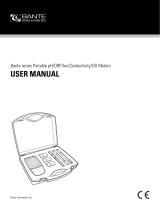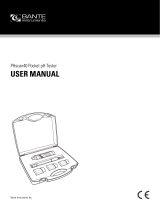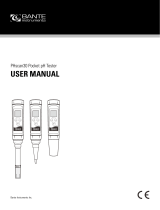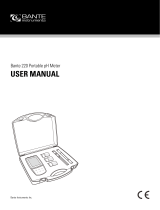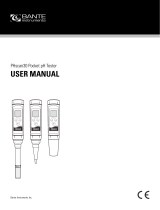Page is loading ...

Bante 210 Benchtop pH Meter
USER MANUAL
Bante Instruments Inc.

1 I Overview
Introduction
Thank you for selecting the 210 benchtop pH meter. This user manual
provides a step-by-step guide to help you operate the meter, please
carefully read the following instructions before use. Any use outside
of these instructions may invalidate your warranty and cause
permanent damage to the meter.
Environmental Conditions
Before unpacking, ensure that current environmental conditions meet
the following requirements.
• Relative humidity is less than 80%
• Ambient temperature between 0° C (32° F) and 50° C (122° F)
• No potential electromagnetic interference
• No corrosive gas exists
Packing List
The following list describes all components of the meter. If any items
are missing or damaged, contact the supplier immediately.
210 meter
Electrode arm
DC 9V power adapter
pH electrode
TP-10K temperature probe
pH buffer reagents 4.01, 7.00, 10.01
Meter Overview
1 Sensor connections
2 Base plate of electrode arm
3 Display
4 Membrane keypad
Connectors
1 Socket for pH or ORP electrode (BNC)
2 Socket for reference electrode (3.5 mm jack)
3 Socket for temperature probe (3.5 mm jack)
4 Socket for power adapter
Display
Icon
Description
Indicates that the meter is in the measurement mode
Indicates that the meter is in the calibration mode
Indicates that the meter is in the setup mode
Indicates that the measurement is locked
If the electrode slope exceeds the allowed range after
calibration, the icon automatically disappears
Indicates that the automatic temperature compensation
is enabled

Overview I 2
Keypad
Key
Function
• Switch the meter on or off
• Lock or unlock the measurement
• Exit the calibration, settings and return to the
measurement mode
Toggle between the pH and mV measurement
modes
• Start calibration
• Press and hold the key to enter the setup menu
Set the temperature
Increase value or scroll up through a list of
options
Decrease value or scroll down through a list of
options
Confirm the calibration or displayed option
Installing the Electrode Holder
Take out the electrode arm from the accessory box. The base plate of
electrode arm has a circular hole, the electrode arm has a connecting
rod. Insert the connecting rod into the circular hole and swivel the
electrode arm 90 degrees. The electrode holder is now ready to swing
into desired position.
Adjusting the Electrode Arm
After installation, if the electrode arm automatically rises or falls, you
are able to adjust the screw until arm locate at any position.
1. Remove the plastic cover from the right side of the electrode
arm.
2. Use the screwdriver to tighten the screw moderately.
3. Insert the plastic cover to previous position.
Connection
Connecting the pH Electrode
1.1 Take out the electrode from packaging. Follow the steps below
to place electrode into the left or right side of the electrode arm.
1.2 Insert BNC connector into the connector socket labeled pH/ISE.
Rotate and push the connector clockwise until it locks.
1.3 After the connection is completed, DO NOT pull on the cable.
Always make sure that the connector is clean and dry.
1
2
3

3 I Overview
Connecting the Temperature Probe
2.1 Place the temperature probe into the circular hole located at the
center of the electrode arm.
2.2 Insert the jack plug to the connector socket labeled ATC. Ensure
the connector is fully seated.
Connecting the Power Adapter
3.1 Insert the connector of power adapter to the power socket.
3.2 Plug the DC 9V power adapter into the wall outlet.
Prior to Use
Remove the protective cap from the bottom of the pH electrode. If.
tiny air bubbles are present inside the pH-sensitive glass membrane,
gently shake the electrode downward to remove air bubbles.
Preparation of pH Buffer Solutions
1. The meter is packaged with pH 4.01, 7.00, 10.01 buffer reagents
required for calibration. Half fill a 250 ml volumetric flask with
distilled water and add the pH 7.00 buffer reagent.
2. Swirl the volumetric flask gently to dissolve the reagent and fill
to the mark with distilled water.
3. Cap and upend the volumetric flask several times to mix the
solution.
• Preparation of pH 4.01 and 10.01 buffer solutions are the same
as above.
• Prepared buffer solution should be stored in hermetically sealed
glass container and avoid direct sunlight.
Switching the Meter On and Off
• Press the Meas key for about 3 seconds and release to switch
on the meter.
• Press and hold the Meas key to switch off the meter.
1
2
3
pH-sensitive glass
membrane
3M KCl solution
250 ml

Setup I 4
Meter Setup
The 210 meter contains an integrated setup menu for customizing the
displayed option to meet measurement requirements. The following
table describes the functions of each menu item.
Menu Item
Option and Description
pH Buffer Group
Set the pH buffer group for calibration and auto-
recognition.
USA (default)
NIST
Calibration Points
Set the number of calibration points.
1 point
2 points (default)
3 points
Measurement Unit
Set the default temperature unit.
Degrees Celsius (default)
Degrees Fahrenheit
Auto-Hold
If enabled, the meter will automatically sense and
lock the measurement endpoint.
Enable
Disable (default)
Auto-Power Off
If enabled, the meter will automatically switch off
if no key is pressed within 3 hours.
Enable
Disable (default)
Factory Reset
Reset the meter to factory default settings. Note,
the meter must be recalibrated.
Enable
Disable (default)
Setting the Default Option
1. In the measurement mode, press and hold the key to enter the
setup menu.
2. Press the / key to select an option, press the Enter key to
confirm and switch to the next menu item.
3. Repeat the steps above until the meter returns to the
measurement mode.
To exit the setup menu without saving changes, press the Meas key.
Temperature Compensation
For better accuracy, we recommend the use of either a sensor with a
built-in or a separate temperature probe. The meter will calculate the
pH slope with measured temperature and show the temperature
compensated readings.
Automatic Temperature Compensation
Connect the temperature probe to meter, the ATC icon appears on the
display, the meter is now switched to the automatic temperature
compensation mode.
Refer to the Connecting the Temperature Probe section on page
3.
Manual Temperature Compensation
If the meter does not detect a temperature probe, the degrees Celsius
icon (°C) will show on the display indicating the meter is switched to
the manual temperature compensation mode. To set the temperature
value follow the steps below.
1. Press the °C key to enter the temperature setting.
2. Press the / key to modify the temperature value.
3. Press the Enter key to save.
Option
Menu item

5 I Calibration
pH Calibration
The 210 meter allows up to 3 points pH calibration. We recommend
that you perform at least 2 points calibration for high accuracy
measurement. The meter will automatically recognize and calibrate
to following standard buffer values.
USA Standard Buffers
pH 4.01, 7.00, 10.01
NIST Standard Buffers
pH 4.01, 6.86, 9.18
Single point calibration should only be carried out with the pH 7.00 or
6.86, otherwise calibration will not be accepted.
Make sure to calibrate the meter when attaching a new pH electrode
or during first use. Do not reuse the buffer solutions after calibration,
contaminants in solution will affect the calibration and eventually the
accuracy of the measurement.
Stir the pH buffer and sample solutions at a uniform rate that will be
obtained most accurate readings.
Setting the Number of Calibration Points
1. Press and hold the key to enter the setup menu.
2. Press the Enter key, the display shows .
3. Press the / key to select 1 or 2 or 3 points calibration.
4. Press the Enter key until the meter returns to the measurement
mode.
Single Point Calibration
1.1 Ensure that the meter is in the pH measurement mode and you
have selected 1 point calibration in the setup menu.
1.2 Press the Cal key, the meter shows / or /
, depending on the selected pH buffer group.
1.3 Rinse the pH electrode with distilled water, place the electrode
(and temperature probe) into the pH 7.00 buffer solution, stir
gently to create a homogeneous solution.
1.4 Press the Enter key, the Calibration icon begins flashing.
1.5 When the reading has stabilized, the meter will show and
return to the measurement mode.
2 Points Calibration
2.1 Ensure that you have selected 2 points calibration in the setup
menu.
2.2 Repeat steps 1.2 through 1.4 above. When the first calibration
point is completed, the display will show /----. The meter
prompts you to continue with second point calibration.
2.3 Rinse the pH electrode with distilled water, place the electrode
(and temperature probe) into the next buffer solution (e.g., pH
4.01).
2.4 Press the Enter key, the meter automatically recognizes the buffer
solution and begins the calibration, the Calibration icon
continuously flashing.
2.5 When the reading has stabilized, the display will show electrode
slope and . Calibration is completed.

Calibration I 6
3 Points Calibration
3.1 Ensure that you have selected 3 points calibration in the setup
menu.
3.2 Repeat steps 1.2 through 1.4 above. When the first calibration
point is completed, the display will shows / . The
meter prompts you to continue with second point calibration.
3.3 Rinse the pH electrode with distilled water, place the electrode
(and temperature probe) into the pH 4.01 buffer solution and stir
gently.
3.4 Press the Enter key, the meter begins calibration, the Calibration
icon continuously flashing.
3.5 Wait for the reading to stabilize, the display will show electrode
slope and / (or / ).
3.6 Rinse the pH electrode with distilled water, place the electrode
(and temperature probe) into the pH 10.01 (or 9.18) buffer solution
and stir gently.
3.7 Press the Enter key, the meter begins the calibration.
3.8 Wait for the reading to stabilize, the display will show electrode
slope and . Calibration is completed.
• During the calibration, if the display shows ---- indicating the
meter is waiting for recognizing the pH buffer solution.
• If the display shows indicating the measured mV value for
the current calibration point deviates by more than 60 mV from
the theoretical value of the pH buffer. The calibration will not be
accepted. Please check the pH electrode and ensure the buffer
solutions are fresh and uncontaminated.
• If the calculated electrode slope is not between 70% to 110%,
icon will disappear from the display. The pH electrode
may need to be replaced.
• To exit the calibration without saving changes, press the Meas
key.
Temperature Calibration
The 210 meter is supplied with a temperature probe for measurement
and temperature compensation. If the measured temperature reading
differs from that of an accurate thermometer, the probe needs to be
calibrated.
1. Connect the temperature probe to the meter and place into a
solution with a known accurate temperature.
2. Press the °C key to enter the temperature setting.
3. Press the / key to modify the temperature value.
4. Press the Enter key to save.
Slope

7 I Measurement
Measurements
pH Measurement
1.1 Rinse the pH electrode with distilled water. Place the electrode
(and temperature probe) into the sample solution and stir gently.
Note, the pH-sensitive glass membrane and liquid junction must
be completely immersed into the solution.
1.2 If the Auto-Hold option in the setup menu is enabled, the meter
will automatically sense a stable reading and lock measurement,
the icon appears on the display. Press the Meas key to resume
measuring.
If the option is disabled, the meter will continuously measure and
update the readings.
1.3 Wait for the measurement to stabilize and record the reading.
1.4 When all of the samples have been measured, rinse the electrode
according to the instructions in the Electrode Maintenance.
• During the measurement process, never wipe the pH-sensitive
membrane as this will cause static interference, blot dry with a
lint-free tissue to remove waterdrops on electrode.
• If the meter shows ---- indicating the measurement exceeds the
range, remove the electrode from the sample immediately.
• If your sample is pure water, low ionic or low conductivity water,
we recommend measuring the pH in the smallest sample volume
possible or adding 0.3 ml of the 3M KCl to 100 ml of the sample
solution. Note, only high purity KCl can be used.
mV Measurement
2.1 Press the Mode key to switch the meter to mV mode.
2.2 Rinse the electrode with distilled water. Place the electrode into
the sample solution and stir gently. Record the reading when the
measurement is stable.
Electrode Maintenance
Cleaning the pH Electrode
Since pH electrode is susceptible to contamination, thoroughly clean
as necessary after each use.
• General Cleaning
Rinse the pH electrode with distilled water and soak in 3M KCl
solution.
• Salt Deposits
Dissolve the deposit by immersing the electrode in warm tap
water. Rinse the electrode with distilled water and soak in 3M
KCl solution.
• Oil or Grease
Place the electrode in the detergent or ethanol solution for 15
minutes. Rinse the electrode with distilled water and soak in 3M
KCl solution.
• Protein
(1) Add 1% pepsin to 0.1M HCl solution.
(2) Place the electrode in above solution for 15 minutes.
(3) Rinse the electrode with distilled water and soak in 3M KCl
solution.
• Clogged Liquid Junction
(1) Heat a diluted KCl solution to 60° C (140° F).
(2) Place the electrode into the heated solution for 10 minutes.
(3) Allow the electrode to cool in unheated KCl solution.
Reactivating the Electrode
If the pH-sensitive membrane has dried out, the electrode response
will become sluggish. Immerse the electrode in a pH 4.01 buffer
solution for about 30 minutes to rehydrate. If this fails, the electrode
requires activation.
1. Soak the electrode in a 0.1M of HCl for 10 minutes.
2. Remove and rinse with distilled water, then place into a 0.1M of
NaOH for 10 minutes.
3. Remove and rinse again, and soak in 3M KCl solution for at least
6 hours.
If these steps fail to restore the response, replace the electrode.
Storing the Electrode
• For best results, always soak the electrode in 3M KCl solution.
• If above solution is not available, use a pH 4.01 buffer solution.
• DO NOT store the electrode in distilled or deionized water that
will deplete the hydration layer of the pH-sensitive membrane
and render the electrode useless.
• If you do not use the electrode for a period longer than 1 month,
store the electrode in storage solution.

Appendix I 8
Appendix
Troubleshooting
Fault
Cause and Corrective Action
Screen shows
Electrode dried out.
Soak the electrode in 3M KCl solution at least 30
minutes.
Measurement exceeded the maximum range.
Check the electrode and sample.
Drifting erratic
readings
Check whether electrode is contaminated, clogged
or broken.
Screen shows
pH buffer problem. Use freshly prepared buffer
solutions to calibrate the meter.
Electrode has expired. Replace pH electrode.
Optional Accessories
pH Electrodes
Order Code
Description
E201-BNC
For general purpose applications
E202-BNC
For measuring the flat surface samples
P11
For measuring the non-high temperature liquids
P11-LiCl
For measuring the non-aqueous samples
P13
For measuring the micro-volume samples
P15
For measuring the low conductivity samples
P16
For measuring the liquids with Tris buffers
P18
For measuring the slurries or soils
P19
For measuring the semisolids
P21
For measuring the colloids
P22
For measuring the high temperature liquids
Temperature Probe
Order Code
Description
TP-10K
Range: 0 to 100° C (32 to 221° F), 1 m (3.3 ft.) cable
Solutions
Order Code
Description
PHCS-USA
pH 4.01, 7.00, 10.01 buffer solutions, 480 ml
PHCS-NIST
pH 4.01, 6.86, 9.18 buffer solutions, 480 ml
PHCS-ES
Electrode storage solution, 480 ml
PHCS-GC
Removes inorganic residues, 480 ml
PHCS-PR
Removes protein contamination, 480 ml
Power Supply
Order Code
Description
DCPA-9V
DC 9V power adapter, european standard plug
Meter Specifications
Model
Bante 210
pH
Range
-1.00 to 15.00 pH
Resolution
0.01 pH
Accuracy
± 0.01 pH
Calibration Points
1 to 3 points
pH Buffer Options
USA (pH 4.01, 7.00, 10.01)
NIST (pH 4.01, 6.86, 9.18)
Temperature Compensation
0 to 100° C (32 to 212° F), manual or
automatic
mV
Range
-1999 to 1999 mV
Resolution
1 mV
Accuracy
± 1 mV
Temperature
Range
0 to 105° C (32 to 221° F)
Resolution
0.1° C (0.1° F)
Accuracy
± 1° C (± 1.8° F)
Calibration Point
1 point
Other Specifications
Operating Temperature
0 to 50° C (32 to 122° F)
Storage Temperature
0 to 60° C (32 to 140° F)
Relative Humidity
< 80% (non-condensing)
Display
LCD, 135 × 75 mm (5.3 × 2.9 in.)
Power Requirements
DC 9V/400mA power adapter
Auto-Off
3 hours after last key pressed
Dimensions
210 (L) × 205 (W) × 75 (H) mm,
(8.2 × 8.0 × 2.9 in.)
Weight
1.5 kg (3.3 lb)

The information in this document is subject to change without notice.
Copyright © Bante Instruments Inc, 2022. All rights reserved.
Disposal
This product is required to comply with the European Union’s Waste
Electrical and Electronic Equipment (WEEE) Directive 2002/96/EC and
may not be disposed of in domestic waste. Please dispose of product
in accordance with local regulations at the collecting point specified
for electrical and electronic equipment.
Warranty
The warranty period for meter is one year from the date of shipment.
Above warranty does not cover the electrode and pH buffer solutions.
Out of warranty products will be repaired on a charged basis.
The warranty on your meter shall not apply to defects resulting from:
• Improper or inadequate maintenance by customer
• Unauthorized modification or misuse
• Operation outside of the environment specifications of the
products.
For more information, please contact the supplier.
Office: 4715 Castlewood St., Sugar land, TX 77479, USA
Tel: (+1) 346-762-7358
E-mail: banteinstruments@yahoo.com
Factory: F3, Building 2, No.2185, Laifang Rd., Shanghai 201615, China
Tel: (+86) 21-6404-1598
E-mail: banteinstrument@hotmail.com
www.bante-china.com
/

